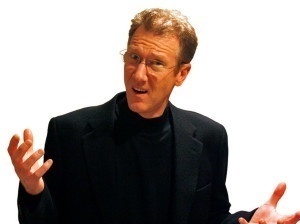Often on Fridays, I’ll schedule something a little lighter, but then again, we’re all about changing things up to stimulate new thinking. Today’s piece from Bill Mullins is a response to an earlier piece on the idea of organizational body language. When Bill responds to a blog post, it’s with an incredible level of reflection that ALWAYS outstrips the original blog post. He connects “Zen and the Art of Motorcycle Maintenance,” (affiliate link) his personal exploration of the past two years, the introduction of thinking on individual body language, and what it all means today for workers trying to read signals from their employers.
My advice? Read it today, and then come back to it this weekend for a re-read. Bill’s thinking always reveal new insights the second and third time around!
ZAMM, Bandwidth, and Does Organizational Body Language Exist? – by Bill Mullins
 Recently, I was talking to a young digerati-innovation guy (20-something) after a meet up at the Google Fiber Center. He shared that he had finally gone back to reading“Zen and the Art of Motorcycle Maintenance,” (affiliate link) after giving up on it in high school. For myself, I finally read it when I was in my 40’s (so maybe he’s ready sooner than I was - or maybe not); I can say it’s been for me one of those gifts that keeps on giving.
Recently, I was talking to a young digerati-innovation guy (20-something) after a meet up at the Google Fiber Center. He shared that he had finally gone back to reading“Zen and the Art of Motorcycle Maintenance,” (affiliate link) after giving up on it in high school. For myself, I finally read it when I was in my 40’s (so maybe he’s ready sooner than I was - or maybe not); I can say it’s been for me one of those gifts that keeps on giving.
A Current Journey for a Chautauqua-Like Experience
I did a Wikipedia check on ZAMM (everything has an acronym these days) and found the write up there felt pretty true to my reading of the book. That got me into fugue-ish reflection on embracing the twin themes of rational and romantic perspectives. From there I leapt to the realization that for the past two years (starting with the Google Fiber Brainzooming day I’d have to say) I’ve been on my own version of the long journey of Chautauqua-like experience that the Pirsig narrative describes.
For me that has been more of a walk-about as most of the places I’ve stopped for reflection are within a bus commute here in KC. And of course, I’ve often revisited a number of spots, like the SMCKC monthly, the MBIT events, and lately the KCI ATAG. I would readily acknowledge that my overarching aim in the Knowledge domain is the same one as Pirsig. To that I’ve added a search for Risk Insights as actionable aides for navigating enterprise in complex, high-consequence circumstances.
What’s different in 2013 from 1973 of course is the enormous growth of bandwidth in which the exchange of views occurs – that and the leaps in understanding of cognitive function in both individuals and groups. I was in the Submarine business in 1973 and we certainly had a well-formed idea of Strategic Impact; we also had technology with bandwidth that is just now coming into the public domain. So what, I’m wondering, is different – and what not so much!
It was in the context of all that cobbled together recognition that I resonated with your note about organizational body language. One other recent event was weighing on my reactions as well. I attended an all-day gathering under the banner of Creating Community Solutions – a White House sponsored event related to raising Mental Health Awareness and community support for at-risk persons.
We heard Secretary Sebelius give a great keynote: my take home was, “While it is vital that we (in DC) make and implement laws to improve access and support for better mental health, it is also necessary that misrepresentations and negative beliefs (about mental health challenges) be addressed in local communities.”
The Advent of Body Language
So what thoughts about organizational body language are triggered for me this morning? Already, by the late 60’s when I was in college, clinical researchers were beginning to highlight the bandwidth segment that we call “personal body language.” At the time, we didn’t talk about bandwidth of course; the tendency was to think that in face to face conversation we are all “acting” symbolically to some extent.
Recognizing whether someone’s symbolic actions reflected or contradicted their spoken words seemed like a skill that wasn’t too difficult to learn and also to be conscious of in ourselves. At the time, applying those insights in the workplace seemed focused on one-to-one or manager-to-subordinate settings that unfolded in pretty much top down and otherwise controlled circumstances.
This was pretty much narrowband communication by today’s standards; a second point is that generally those were the glory times in America – people who learned about paying attention to body language were typically in large, growing, and generally prosperous organizations. These had large supply chains like the auto and defense industries and were still manufacturing capital intensive. That meant lots of contextual clues about what was important on most days, and the clues didn’t change very quickly.
Major brands, major advertising agencies, relatively WYSIWYG media campaigns, were all the norm – together with lots of small, local customer to owner business outlets for reaching the brands as consumers. I can remember when Detroit Edison sold appliances from a space in their office building that was as big as a car showroom – talk about organizational body language and brand consistency.
Does organizational body language exist?
Today, from the standpoint of an individual worker, the picture is a lot muddier for a couple of reasons:
- The economy still stinks and people who have a job are not feeling very risk tolerant – rather they are anxious not to misstep – this can adversely impact the clarity with which they read the intentions of management even when those are clear to a third party;
- The vertical connectivity between employees and those who create the brand presence today is much more fragmented; many senior managers are oriented toward stakeholders outside the organization and can’t, don’t, or won’t spend comparable time working the internal messages with comparable commitment to effectiveness;
- There is much more bandwidth in play with internal communications (forget the external stuff for the moment) – but often it is multiple narrowband channels (I think even Twitter and Facebook are still pretty narrowband) crowded into the same limited, series, sequential personal attention span
- The degree of internal message alignment ranges from incoherent fragmentation to brute force consistency – and the good examples of balance may yet not exist – they certainly aren’t widely known to irregular observers like me
So with all of that, I’m wondering if the meme of “body language” really scales up beyond the individual?
Maybe it’s just me, but I find I’m getting crankier these days about metaphors and analogies that assume the “signal to noise” ratio on the receiving end is conducive to effective hearing. There are certainly places where that is the case – but they probably don’t need the advice right? Perhaps a reflection on listener to broadcaster bandwidth mismatches would make a companion piece? - Bill Mullins



